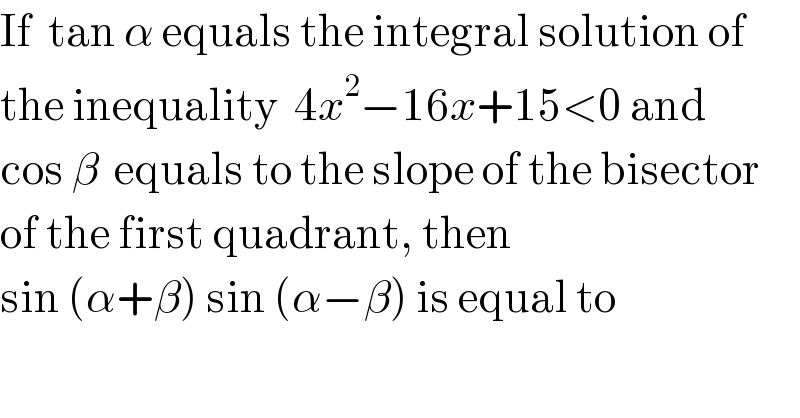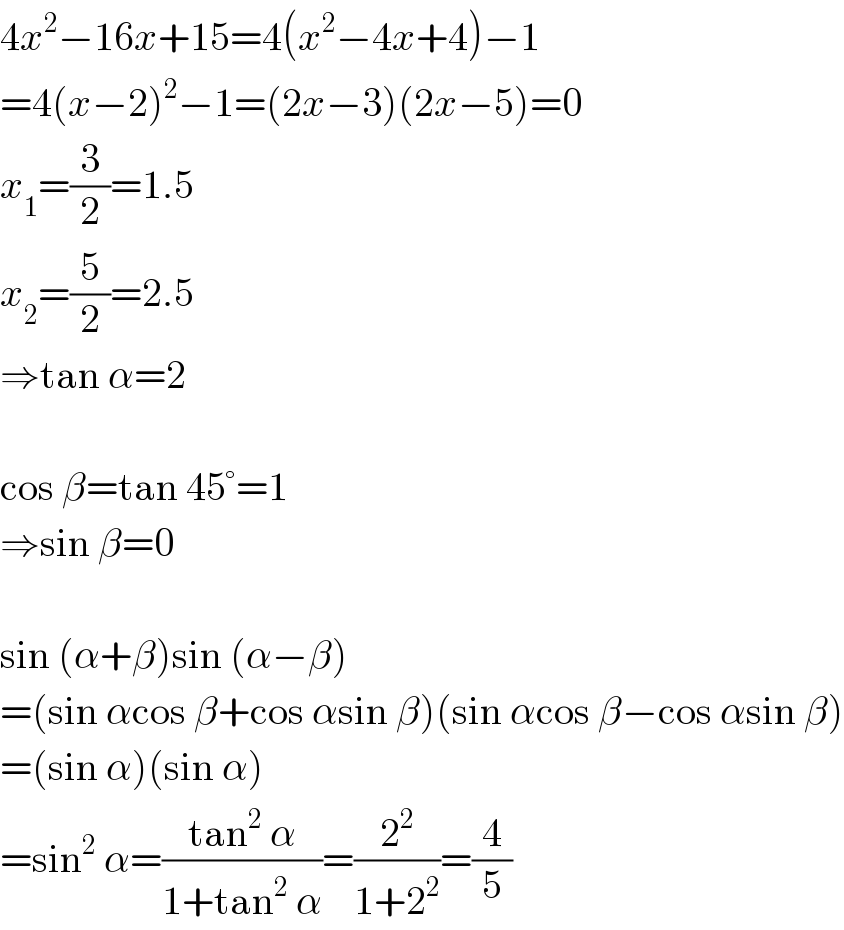Question Number 12169 by indreshpatelindresh@435gmail.i last updated on 15/Apr/17

$$\mathrm{If}\:\:\mathrm{tan}\:\alpha\:\mathrm{equals}\:\mathrm{the}\:\mathrm{integral}\:\mathrm{solution}\:\mathrm{of} \\ $$$$\mathrm{the}\:\mathrm{inequality}\:\:\mathrm{4}{x}^{\mathrm{2}} −\mathrm{16}{x}+\mathrm{15}<\mathrm{0}\:\mathrm{and}\: \\ $$$$\mathrm{cos}\:\beta\:\:\mathrm{equals}\:\mathrm{to}\:\mathrm{the}\:\mathrm{slope}\:\mathrm{of}\:\mathrm{the}\:\mathrm{bisector} \\ $$$$\mathrm{of}\:\mathrm{the}\:\mathrm{first}\:\mathrm{quadrant},\:\mathrm{then}\: \\ $$$$\mathrm{sin}\:\left(\alpha+\beta\right)\:\mathrm{sin}\:\left(\alpha−\beta\right)\:\mathrm{is}\:\mathrm{equal}\:\mathrm{to} \\ $$
Answered by mrW1 last updated on 15/Apr/17

$$\mathrm{4}{x}^{\mathrm{2}} −\mathrm{16}{x}+\mathrm{15}=\mathrm{4}\left({x}^{\mathrm{2}} −\mathrm{4}{x}+\mathrm{4}\right)−\mathrm{1} \\ $$$$=\mathrm{4}\left({x}−\mathrm{2}\right)^{\mathrm{2}} −\mathrm{1}=\left(\mathrm{2}{x}−\mathrm{3}\right)\left(\mathrm{2}{x}−\mathrm{5}\right)=\mathrm{0} \\ $$$${x}_{\mathrm{1}} =\frac{\mathrm{3}}{\mathrm{2}}=\mathrm{1}.\mathrm{5} \\ $$$${x}_{\mathrm{2}} =\frac{\mathrm{5}}{\mathrm{2}}=\mathrm{2}.\mathrm{5} \\ $$$$\Rightarrow\mathrm{tan}\:\alpha=\mathrm{2} \\ $$$$ \\ $$$$\mathrm{cos}\:\beta=\mathrm{tan}\:\mathrm{45}°=\mathrm{1} \\ $$$$\Rightarrow\mathrm{sin}\:\beta=\mathrm{0} \\ $$$$ \\ $$$$\mathrm{sin}\:\left(\alpha+\beta\right)\mathrm{sin}\:\left(\alpha−\beta\right) \\ $$$$=\left(\mathrm{sin}\:\alpha\mathrm{cos}\:\beta+\mathrm{cos}\:\alpha\mathrm{sin}\:\beta\right)\left(\mathrm{sin}\:\alpha\mathrm{cos}\:\beta−\mathrm{cos}\:\alpha\mathrm{sin}\:\beta\right) \\ $$$$=\left(\mathrm{sin}\:\alpha\right)\left(\mathrm{sin}\:\alpha\right) \\ $$$$=\mathrm{sin}^{\mathrm{2}} \:\alpha=\frac{\mathrm{tan}^{\mathrm{2}} \:\alpha}{\mathrm{1}+\mathrm{tan}^{\mathrm{2}} \:\alpha}=\frac{\mathrm{2}^{\mathrm{2}} }{\mathrm{1}+\mathrm{2}^{\mathrm{2}} }=\frac{\mathrm{4}}{\mathrm{5}} \\ $$
